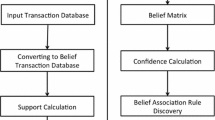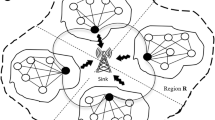Abstract
Wireless sensor networks (WSNs) have recently received increasing attention in the areas of defense and civil applications of sensor networks. Automatic WSN fault detection and diagnosis is essential to assure system’s reliability. Proactive WSNs fault diagnosis approaches use embedded functions scanning sensor node periodically for monitoring the health condition of WSNs. But this approach may speed up the depletion of limited energy in each sensor node. Thus, there is an increasing interest in using passive diagnosis approach. In this paper, WSN anomaly detection model based on autoregressive (AR) model and Kuiper test-based passive diagnosis is proposed. First, AR model with optimal order is developed based on the normal working condition of WSNs using Akaike information criterion. The AR model then acts as a filter to process the future incoming signal from different unknown conditions. A health indicator based on Kuiper test, which is used to test the similarity between the training error of normal condition and residual of test conditions, is derived for indicating the health conditions of WSN. In this study, synthetic WSNs data under different cases/conditions were generated and used for validating the approach. Experimental results show that the proposed approach could differentiate WSNs normal conditions from faulty conditions. At last, the overall results presented in this paper demonstrate that our approach is effective for performing WSNs anomalies detection.


















Similar content being viewed by others
References
Akyildiz, I., Su, W., Sankarasubramaniam, Y., & Cayirci, E. (2002). Wireless sensor networks: a survey. Computer Networks, 38(4), 393–422.
Megerian, S., Koushanfar, F., Qu, G., Veltri, G., & Potkonjak, M. (2002). Exposure in wireless sensor networks: theory and practical solutions. Wireless Networks, 8, 443–454.
Ni, K., & Pottie, G. (2012). Sensor network data fault detection with maximum a posteriori selection and Bayesian modeling. ACM Transactions on Sensor Networks, 8(3), 23:1–23:21.
Yu, M., Mokhtar, H., & Merabti, M. (2007). Fault management in wireless sensor networks. IEEE Wireless Communications, 14(6), 13–19.
Liu, W., Zhang, Y., Lou, W., & Fang, Y. (2006). A robust and energy-efficient data dissemination framework for wireless sensor networks. Wireless Networks, 12, 465–479.
Rosberg, Z., Liu, R. P., Dinh, T. L., Dong, Y. F., & Jha, S. (2010). Statistical reliability for energy efficient data transport in wireless sensor networks. Wireless Networks, 16, 1913–1927.
Anisi, M. H., Abdullah, A. H., & Razak, S. A. (2013). Energy-efficient and reliable data delivery in wireless sensor networks. Wireless Networks, 19, 495–505.
Sung, T.-W., Wu, T.-T., Yang, C.-S., & Huang, Y.-M. (2010). Reliable data broadcast for Zigbee wireless sensor networks. International Journal on Smart Sensing and Intelligent Systems, 3(3), 504–520.
Zigbee: Setting standards for energy-efficient control networks, Schneider, http://www2.schneider-electric.com/documents/support/white-papers/40110601_Zigbee_EN.pdf.
AboElFotoh, H. M. F., Iyengar, S. S., & Chakrabarty, K. (2005). Computing reliability and message delay for cooperative wireless distributed sensor networks subject to random failures. IEEE Transactions on Reliability, 54(1), 145–155.
AboElFotoh, H. M. F., Elmallah, E., & Hassanein, H. (2006). On the reliability of wireless sensor networks. In IEEE international conference on communications (pp. 3455–3460).
Jin, X., Ma, E. W. M., Cheng, L. L., & Pecht, M. (2012). Health monitoring of cooling fan based on Mahalanobis distance with mRMR feature selection. IEEE Transactions on Instrumentation and Measurement, 61(8), 2222–2229.
Jin, X., & Chow, T. W. S. (2013). Anomaly detection of cooling fan and fault classification of induction motor using Mahalanobis–Taguchi system. Expert Systems with Applications, 40(15), 5787–5795.
Son, J.-D., Niu, G., Yang, B.-S., Hwang, D.-H., & Kang, D.-S. (2009). Development of smart sensors system for machine fault diagnosis. Expert Systems with Applications, 36(9), 11981–11991.
Wang, Y., Miao, Q., Ma, E. W. M., Tsui, K.-L., & Pecht, M. G. (2013). Online anomaly detection for hard disk drive based on Mahalanobis distance. IEEE Transactions on Reliability, 62(1), 136–145.
Rabatel, J., Bringay, S., & Poncelet, P. (2011). Anomaly detection in monitoring sensor data for preventive maintenance. Expert Systems with Applications, 38(6), 7003–7015.
Liu, Y., Liu, K., & Li, M. (2010). Passive diagnosis for wireless sensor networks. IEEE/ACM Transactions on Networking, 18(4), 1132–1144.
Paradis, L., & Han, Q. (2007). A survey of fault management in wireless sensor networks. Journal of Network and Systems Management, 15(2), 171–190.
Jiang, P. (2009). A new method for node fault detection in wireless sensor networks. Sensors, 9(2), 1282–1294.
Krishnamachari, B., & Iyengar, S. (2004). Distributed bayesian algorithms for fault-tolerant event region detection in wireless sensor networks. IEEE Transactions on Computers, 53(3), 241–250.
Lee, M.-H., & Choi, Y.-H. (2008). Fault detection of wireless sensor networks. Computer Communications, 31(14), 3469–3475.
Wang, S.-S., Yan, K.-Q., Wang, S.-C., & Li, C.-W. (2011). An integrated intrusion detection system for cluster-based wireless sensor networks. Expert Systems with Applications, 38(12), 15234–15243.
Luo, X., Dong, M., & Huang, Y. (2006). On distributed fault-tolerant detection in wireless sensor networks. IEEE Transactions on Computers, 55(1), 58–70.
Koushanfar, F., Potkonjak, M., & Sangiovanni-Vincentelli, A. (2003). On-line fault detection of sensor measurements. In Proceedings of IEEE sensors (pp. 974–979).
Zhao, Y. J., Govindan, R., & Estrin, D. (2002). Residual energy scan for monitoring sensor networks. In IEEE wireless communications and networking conference (pp. 356–362).
Ramanathan, N., Chang, K., Kapur, R., Girod, L., Kohler, E., & Estrin, D. (2005). Sympathy for the sensor network debugger. In Proceedings of the 3rd international conference on embedded networked sensor systems (pp. 255–267).
Zaidi, Z. R., Hakami, S., Landfeldt, B., & Moors, T. (2010). Real-time detection of traffic anomalies in wireless mesh networks. Wireless Networks, 16, 1675–1689.
Zhao, C., Sun, X., Sun, S., & Jiang, T. (2011). Fault diagnosis of sensor by chaos particle swarm optimization algorithm and support vector machine. Expert Systems with Applications, 38(8), 9908–9912.
Kar, C., & Mohanty, A. R. (2004). Application of KS test in ball bearing fault diagnosis. Journal of Sound and Vibration, 269(1–2), 439–454.
Cong, F., Chen, J., & Pan, Y. (2011). Kolmogorov–Smirnov test for rolling bearing performance degradation assessment and prognosis. Journal of Vibration and Control, 17(9), 1337–1347.
Wang, X., & Makis, V. (2009). Autoregressive model-based gear shaft fault diagnosis using the Kolmogorov–Smirnov test. Journal of Sound and Vibration, 324(3–5), 413–423.
Kay, S. M. (1988). Modern spectral estimation: theory and application. New Jersey: Prentice Hall.
Press, W. H., Flannery, B. P., Teukolsky, S. A., & Vetterling, W. T. (1992). Numerical recipes in Fortran 77: The art of scientific computing. Cambridge: Cambridge University Press.
Wang, W., & Wong, A. K. (2002). Autoregressive model-based gear fault diagnosis. Journal of Vibration and Acoustics, 124, 172–179.
Shittu, O., & Asemota, M. (2009). Comparison of criteria for estimating the order of autoregressive process: a Monte Carlo approach. European Journal of Scientific Research, 30(3), 409–416.
Lau, C. P. (2013). Failure detection of wireless sensor network. Master’s thesis, City University of Hong Kong, Hong Kong.
Gong, R., & Huang, S. H. (2012). A Kolmogorov–Smirnov statistic based segmentation approach to learning from imbalanced datasets: with application in property refinance prediction. Expert Systems with Applications, 39(6), 6192–6200.
Shibata, R. (1976). Selection of the order of an autoregressive model by Akaike’s information criterion. Biometrika, 63(1), 117–126.
Acknowledgments
The work described in this paper was supported in part by a collaborative project associated with China Electronic Product Reliability and Environmental Testing and Research Institute (CEPREI) from Guangdong Provincial Department of Science and Technology (Project number: 2011A011302002), in part by National Natural Science Foundation of China under Grant No. 51275474, in part by Zhejiang Provincial Natural Science Foundation of China under Grant No. LZ12E05002, and in part by the Open Research Project of the State Key Laboratory of Industrial Control Technology, Zhejiang University, China (No. ICT1443). The authors would like to thank Zhang Fan and Li Dong of CEPRI for providing technical support in this project, and would also like to thank the reviewers for their valuable comments and constructive suggestions to improve this paper.
Author information
Authors and Affiliations
Corresponding author
Rights and permissions
About this article
Cite this article
Jin, X., Chow, T.W.S., Sun, Y. et al. Kuiper test and autoregressive model-based approach for wireless sensor network fault diagnosis. Wireless Netw 21, 829–839 (2015). https://doi.org/10.1007/s11276-014-0820-0
Published:
Issue Date:
DOI: https://doi.org/10.1007/s11276-014-0820-0




